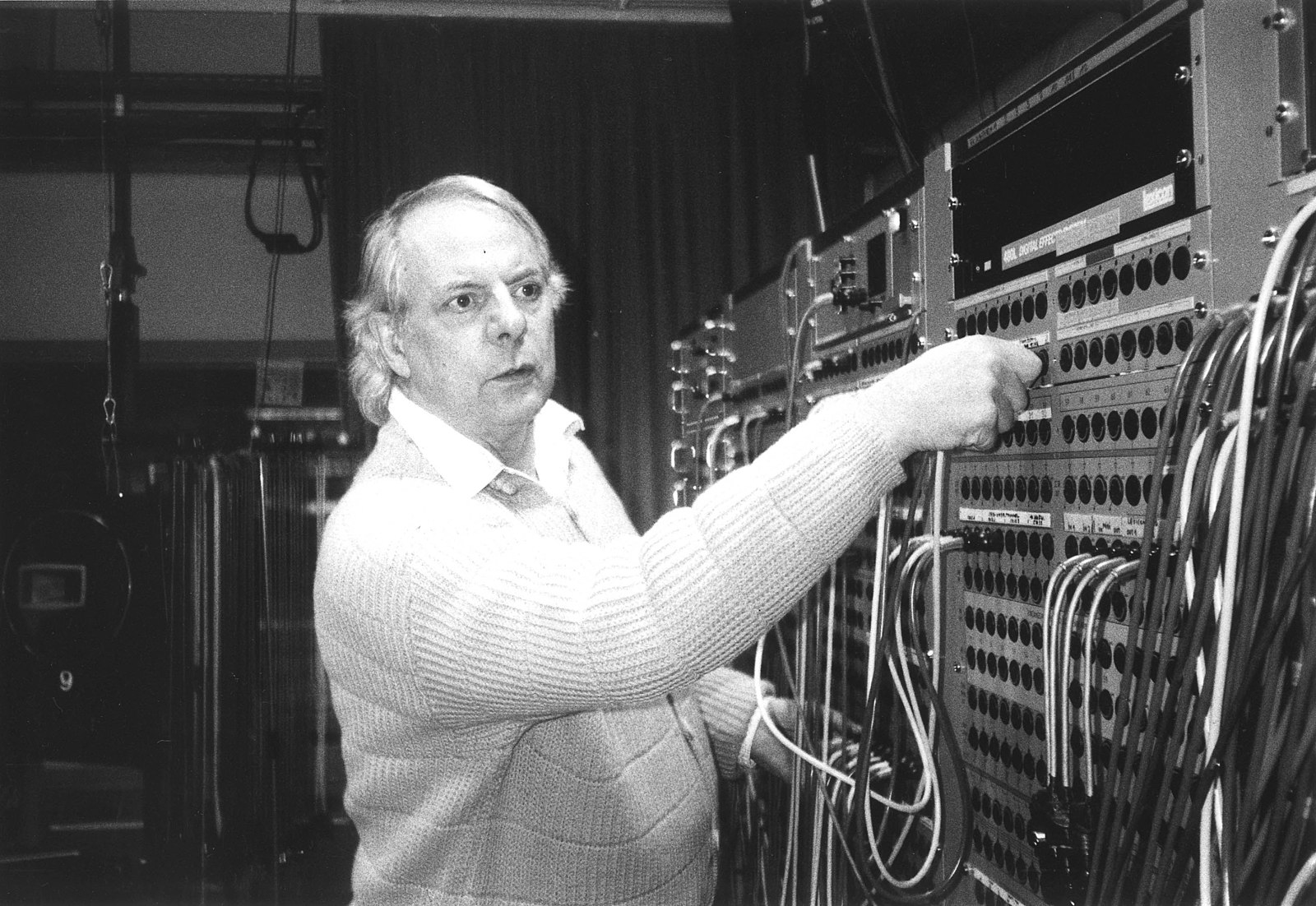
Photo of Karlheinz Stockhausen by Kathinka Pasveer via Wikimedia Commons
You may hear the phrase “electronic music” and think of superstar dubstep DJs in funny helmets at beachside celebrity parties. Alternatively, you may think of the mercurial compositions of Karlheinz Stockhausen, the musique concrete of Pierre Henry, or the otherworldly experimentalism of François Bayle. If you’re in that latter camp of music nerd, then this post may bring you very glad tidings indeed. Ubuweb—that stalwart repository of all things 20th-century avant-garde—now hosts an extraordinary compilation: the 476-song History of Electronic/Electroacoustic Music, originally a 62 CD set. (Hear below Stockhausen’s “Kontact,” Henry’s “Astrologie,” and Bayle’s spare “Theatre d’Ombres” further down.)
Spanning the years 1937–2001, the collection should especially appeal to those with an avant-garde or musicological bent. In fact, the original uploader of this archive of experimental sound, Caio Barros, put these tracks online in 2009 while a student of composition at Brazil’s State University of São Paulo. Barros’ “initiative,” as he writes at Ubuweb, “became some sort of legend” among musicophiles in the know.
And yet, Ubuweb reposts this phenomenal collection with a disclaimer: “It’s a clearly flawed selection,” they write:
There’s few women and almost no one working outside of the Western tradition (where are the Japanese? Chinese? etc.). However, as an effort, it’s admirable and contains a ton of great stuff.
Take it with a grain of salt, or perhaps use it as a provocation to curate a more intelligent, inclusive, and comprehensive selection
It’s a fair critique, though Barros points out that the exclusions mostly have to do with “the way our society and the tradition this music represent works” (sic). And yet, as disciplinary boundaries expand all the time, and histories broaden along with them, that description no longer holds. It would be a fascinating exercise, for example, to listen to these tracks alongside the history of women in electronic music, 1938–2014 that we posted recently.
Also, there’s clearly much more to electronic music than either celebrity DJs or obscure avant-garde composers. Many hundreds of popular electronic composers and musicians—like Brian Eno, Kraftwerk, Bruce Haack, or Clara Rockmore—fall somewhere in-between the worlds of pop/dance/performance and serious composition, and their contributions deserve representation alongside more experimental or classical artists.
All that said, however, there’s no reason you can’t curate your own playlist of the history of electronic music as you see it—drawing from the astounding wealth of music available free at The History of Electroacoustic Music. Or consider this collection a fully immersive course in “traditional, western avant-garde electronic music” from “the area of Europe-America,” as Barros puts it. As that, it succeeds admirably.
Note: An earlier version of this post appeared on our site in 2016.
Related Content:
What is Electronic Music?: Pioneering Electronic Musician Daphne Oram Explains (1969)
Hear Seven Hours of Women Making Electronic Music (1938- 2014)
Josh Jones is a writer and musician based in Durham, NC. Follow him at @jdmagness


No Doctor Who Theme? Like compiling a history of pop music and not including the Beatles.
Including Delia Derbyshire could’ve improved the collection’s feminist bona fide immensely, too.
But by the time I was 1/3 of the way through the list (and already tired of scrolling past the endless clusters of a dozen numbered variations on the same piece), I had already realized this wasn’t a history of electronic music. It’s a history of pretentious twaddle that happens to have an electrical cord attached.
Absolutely. The Doctor Who theme is ground zero for the UK in terms of electronic music outside of academia and “high art”
Kraftwerk 😮
Listen to the three pieces by Stockhausen, Henry and Bayle, with the same mindset as you would looking at cubist or abstract expressionist paintings by Braque, Pollock or Twombly. Delia Derbyshire’s electronic treatment of the Dr. Who theme is an example of “figurative e‑music”- i.e. the objects invoked include the Dalek and Dr. Who’s Tardis :)
Speaking of which, no “Revolution No. 9”?
Come on man, that’s too easy. Some people try to take the next step, the next method, the next concept, move forward, the next way of experiencing and making music.
Personally, I get bored again immediately when electronic music gets a beat or groove. Always those loops and grooves and the shaking heads, why can we not get rid of that. That’s a superficial, very limited way of experiencing music.
The composer Varese talked about ‘The Liberation of Sound’. He came from the first half of the 20th century. Actually, people who make electronic music with beats and grooves, are like 125 years ago. They lock sound in, in a straitjacket, in grooves. It’s more limited than classical music, which at least has an elastic use of time, in the service of expression and depth. And that was the music Varese wrote his ‘The Liberation of Sound’ for.
i agree. when you look on the harmonic structure of beat or groove orientated electronic music, its even more than 125 years behind. the problem is,that these people want to make real music, but focussing on tech rhythms even prevents real music, and nearly nobody is able to see whats really going on and tell a story about it. I would prefer, that thex would leave the nerdy and distracting 16th groove out and focus on those simple changes, they can really imagine. This would show their boredom in a medievil sound, but would be at least honest.
The creator of the list: “Take it with a grain of salt”
The article: “Here’s some other ways the list may have missed the mark.”
The comments: ‘WHY DIDN“T THEY INCLUDE MY FAVORITE ‘EVERY HOLST SUITE PLAYED ON A MOOG BACKWARD’ ”